How fashion designers flipped to athleisure during Covid
 Leon Elias Wu
Leon Elias WuFashion designer Leon Elias Wu says that when the pandemic first hit he felt as if he was "a character in a zombie apocalypse film".
"I went into autopilot... my first real thoughts and feelings were concern about my family and loved ones," says the Los Angeles-based 42-year-old.
"And then I thought about the economy, and how that would impact my business. We had to think quickly... to keep the business afloat during the challenging times ahead."
Mr Wu is a designer of bespoke suits beloved by a number of Hollywood actors, including Laverne Cox, Beth Dover, and Jake Graf.
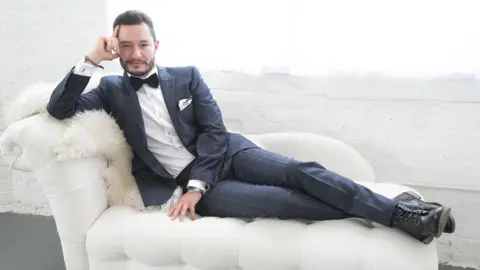 SharpeHaus
SharpeHausLike most high-end fashion bosses, he suddenly found that with no-one able to go out to big events, such as film premiers, or even just to a fancy restaurant, far fewer people wanted to buy a expensive suit.
So Mr Wu decided he had to pivot his business. With everyone isolating at home he launched a range of "athleisure" clothing - sporty leisurewear, such as sweatshirts and leggings, that can be worn both while exercising or simply while relaxing and lounging around.
Here he speaks of his experience, as do four other fashion designers who have made similar moves over the past year to keep the money coming in.
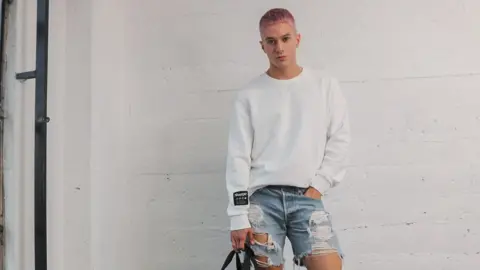 SharpeHaus
SharpeHausMr Wu says that at the start of the pandemic his first reaction was to offer clients a 20% discount if they prepaid for future suits. But even with that financial incentive his suit sales fell 40% last year.
It was then that he decided to also start designing athleisure wear, launching a range of hoodies and sweatshirts under the brand name SharpeHaus. Mr Wu, who is a transgender man, says he designed all the new clothing items to be gender inclusive, and appeal equally to a female, male and non-binary audience.
SharpeHaus is also continuing to make a series of music videos on YouTube that involve lesbian, gay, bisexual and transgender artists covering classic 1980s songs. It is doing so to raise funds for Cyndi Lauper's True Colors United homelessness charity.
Icelandic designer Sigrun Bjork Olafsdottir makes couture dresses inspired by Nordic and Viking legend.
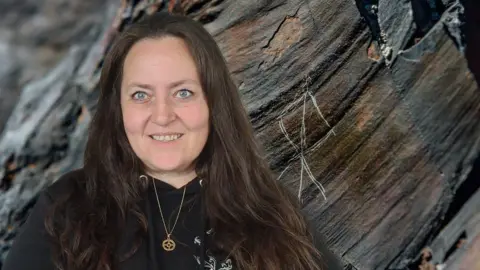 Sigrun Bjork Olafsdottir
Sigrun Bjork OlafsdottirShe says that "one minute" she was participating at the House of iKons' Fashion Week in London in February 2020, "and the next I was locked at home wondering how to continue pursing my passion for design".
Floored by what was happening, the 50-year-old had to take "a step back" and re-focus. "The way to do that was to look at what was needed," she says. "Ready-to-wear in the form of trendy athleisure wear was the answer, and there began my transition away from high-drama couture."
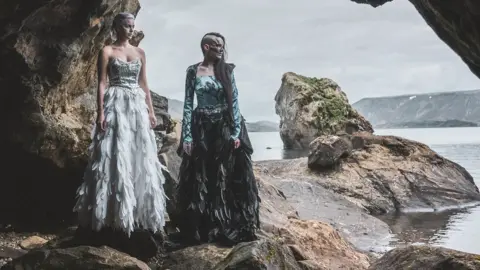 Sigrun Design
Sigrun DesignHowever, she and her company - Sigrun Design - did not find it an easy pivot. "This has been a very expensive transition, as it isn´t an easy path to manoeuvre, and the industry is very elusive to newcomers in the athleisure field."
Nevertheless, Ms Olafsdottir remains hopeful that her new clothing lines will sell.
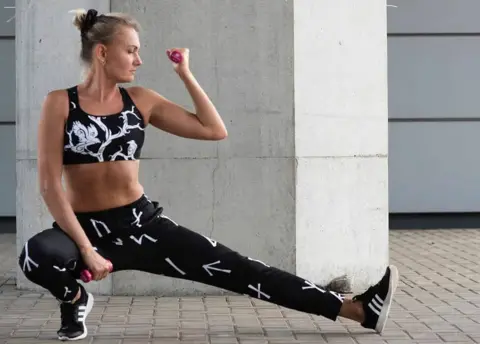 Sigrun Design
Sigrun Design"The revenue has increased, but so has the cost, and I still haven't made up the start-up funding. So I can't say that this pivot has made a huge difference in terms of finances.
"But building an online presence takes a lot of time and money, and so, it is gradually increasing. This has to be seen as an investment."
Brandon Hunt, the boss of Dallas-based fashion label Livintage Apparel, says the pandemic hit him hard because he had only recently become a father. "The shock was unreal," he says. "My family and I did everything we could to stay safe. We were overly cautious and managed to stay in quarantine for months."
The former model had been designing angular, tough-looking "streetwear" - such as leather jackets and thigh length boots - but switched to designer hoodies and jogging trousers because people stuck at home "wanted comfortable clothing that would still look stylish for virtual meetings".
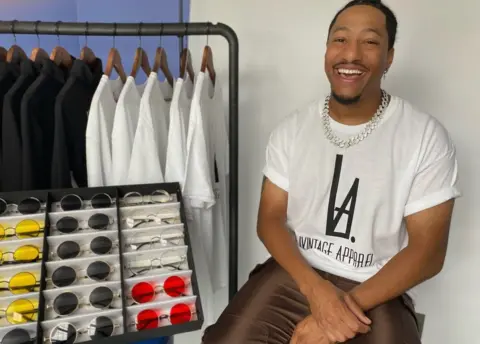 Brandon Hunt
Brandon Hunt"Expanding my inventory was definitely a challenge for me during this uncertain time," says the 33-year-old. "I had to think outside of the box and figure out what would be most successful.
"It was not only a time where people weren't out shopping as much for new pieces, but there were shortages in fabrics. It was much harder to be hands on with manufacturers."
Yet, despite these problems he says his first men's and women's collections sold out quickly. "I also have a monthly subscription, where clients can be styled and receive new items. This has motivated me so much, I am already at work on my next custom loungewear items."
Elisabeth Weinstock used to make expensive snakeskin leather goods, everything from jackets to handbags and wallets under her eponymous brand.
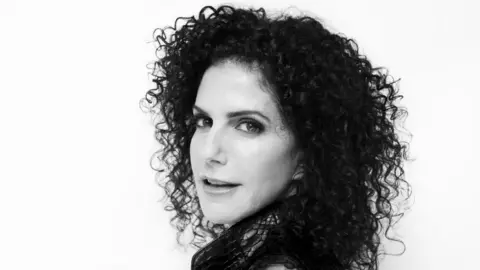 Elisabeth Weinstock
Elisabeth WeinstockDuring the pandemic she launched a range of women's loungewear and sleepwear under the name Andine.
"It was easy for me to start small, buy my own machines and find incredible craftsmen who are excellent sewers to work in-house," she says. "Thus far, everything is cut and sewn in our building [in Los Angeles]."
Ms Weinstock said that "most anything" is cheaper to produce than a snakeskin item. "The price points are not comparable, and the clientele is different as well. While it's too new to discuss financials, the initial response has been amazing."
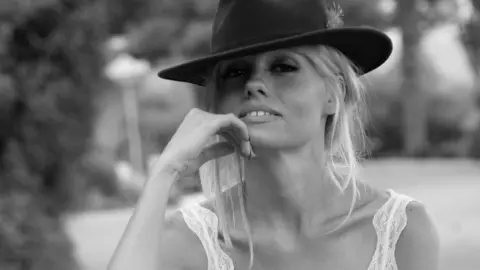 Andine
AndineWhile most women in their late 70s would be perhaps taking things a little easy, Ellen Curtis has launched her own fashion business - Statement by Ellen C.
Prior to the pandemic, the 77-year-old was working as a psychiatric nurse providing patients with in-home addiction and detox support and care. "But when Covid hit, my doctor recommended I stop working - the mental stress coupled with the virus was just too risky for a senior," she says.
But instead of retiring, she "decided to explore my love of fashion by creating upscale, custom-designed denim jackets and masks, which also meant learning to sew!".
Then, with people stuck at home, the Los Angeles-based Ms Curtis expanded to a range of athleisure clothing to boost sales.
"In many ways, the loungewear presented fewer challenges," she says. "Leisure fabrics are easier to work with than denim, and require fewer embellishments, so pieces come together faster and ultimately cost less to create.
"With the price lower and the demand for fun casual fashion higher, my loungewear is also more accessible to customers."
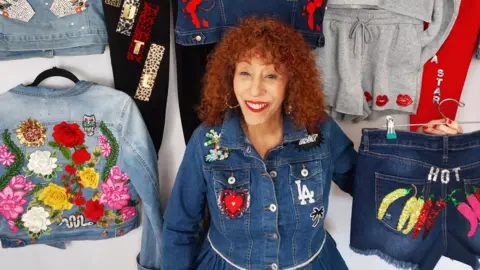 Ellen Curtis
Ellen CurtisPippa Stephens, retail analyst at research group GlobalData, says this move to athleisure clothing has been replicated across the largest fashion labels.
"As the suppression of Covid-19 allows social events to gradually resume, consumers will begin to look for more going-out appropriate styles once again" she says.
"However, since increased home working is likely to be a long-term trend, and consumers have now got used to more comfortable outfits, non-sportswear specialists should still ensure that they continue to offer some athleisure options to suit consumers' adjusted lifestyles."
